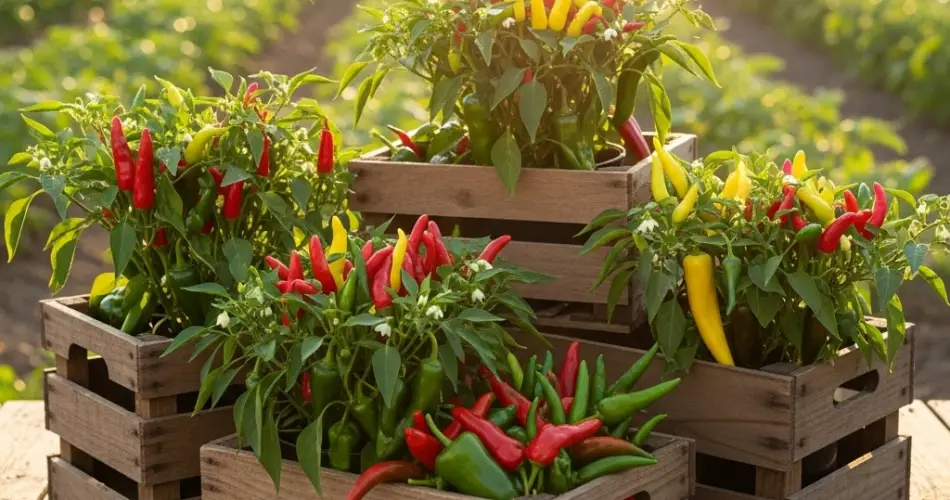Chilies are a favorite among home gardeners for their versatility, flavor, and the excitement they bring to meals. Growing them in traditional garden beds is effective, but crate gardening offers a practical solution for small yards, patios, or balconies. Crates allow gardeners to control soil quality, optimize space, and manage plant care more efficiently, resulting in healthy, high-yielding chili plants.
By growing chilies in crates, you can enjoy a manageable, productive garden even in limited outdoor areas. This method provides better drainage, improves airflow, and simplifies harvesting while giving your garden a rustic, organized appearance.
Why Grow Chilies in Crates?
Crate gardening offers multiple advantages for chili cultivation:
-
Space Efficiency – Perfect for urban gardens or small backyards.
-
Soil Control – Allows for custom soil mixes rich in nutrients and organic matter.
-
Mobility – Crates can be moved to optimize sunlight or protect plants from adverse weather.
-
Pest Reduction – Elevated plants are less susceptible to soil-borne pests.
-
Convenience – Crates make watering, feeding, and harvesting easier and more organized.
Additionally, crate gardens provide improved airflow, which reduces the risk of fungal diseases and promotes stronger plant growth.
Selecting the Right Crates
For successful chili cultivation, choose crates that are:
-
Deep – At least 12–16 inches to accommodate robust root systems.
-
Spacious – Large enough for multiple plants without overcrowding.
-
Sturdy and Untreated – Avoid chemically treated wood to prevent contamination.
-
Well-Draining – Ensure holes or slats at the bottom to allow excess water to escape.
Lining crates with burlap or landscape fabric helps retain soil while still allowing water to drain efficiently.
Choosing Chili Varieties
Select varieties based on flavor, heat level, and plant size:
Mild Varieties:
-
Jalapeño
-
Cherry Pepper
-
Pimiento
Hot Varieties:
-
Thai Bird’s Eye
-
Cayenne
-
Habanero
For small crates, compact bush varieties are ideal, while taller or vining chilies may require stakes or cages for support.
Materials Needed
-
Wooden crate (12–16 inches deep)
-
High-quality potting mix with compost
-
Chili seedlings or seeds
-
Stakes, cages, or trellises for support
-
Mulch (straw, shredded leaves, or coco husk)
-
Fertilizer or compost tea
-
Sunny location with 6–8 hours of direct sunlight
Planting Chilies in Crates
-
Prepare the Soil
Fill the crate with a nutrient-rich, well-draining soil mix. Incorporate compost or organic fertilizer to support vigorous growth. -
Transplant Seedlings
Space seedlings 12–18 inches apart depending on variety. Plant slightly deeper than nursery pots to strengthen root systems. -
Direct Sowing
If sowing seeds, plant them about ¼ inch deep. Thin seedlings once they develop several leaves to prevent overcrowding. -
Providing Support
Install stakes, cages, or trellises at planting time for vining varieties to prevent breakage under fruit weight and ensure vertical growth.
Caring for Crate-Grown Chilies
-
Watering – Maintain consistent soil moisture, especially during flowering and fruiting. Avoid wetting leaves to reduce disease risk.
-
Feeding – Fertilize every 2–3 weeks with balanced fertilizer or compost tea to promote strong foliage and fruit development.
-
Mulching – Apply 2–3 inches of mulch around the base to conserve moisture, regulate soil temperature, and suppress weeds.
-
Pruning – Remove damaged or overcrowded leaves to improve airflow and direct energy toward fruit production.
Managing Pests and Diseases
Even in crates, chili plants can face common garden pests and diseases:
-
Aphids – Use insecticidal soap or a gentle water spray to remove them.
-
Whiteflies – Monitor regularly and apply organic deterrents if needed.
-
Fungal Issues – Ensure adequate spacing, airflow, and avoid overhead watering. Rotate soil each season to reduce disease buildup.
Harvesting Chilies
Harvest chilies when they reach full color and size according to the variety. Regular picking encourages continuous production throughout the growing season. Use scissors or gently twist the fruit off to avoid damaging stems. Green chilies can be harvested early, while leaving them to ripen enhances flavor and heat.
Extending the Growing Season
In cooler climates or early frosts, crates can be relocated to warmer, sheltered areas or covered with row covers. Chilies will continue producing as long as they receive adequate sunlight and warmth.
Final Thoughts
Growing chilies in crates is an efficient, practical, and productive approach for gardeners with limited space. With the right crate, nutrient-rich soil, and consistent care, you can enjoy a bountiful harvest of flavorful chilies right in your backyard, patio, or balcony. Crate gardening combines functionality, organization, and charm, making it an excellent choice for both novice and experienced home gardeners looking to cultivate spicy, healthy vegetables.



